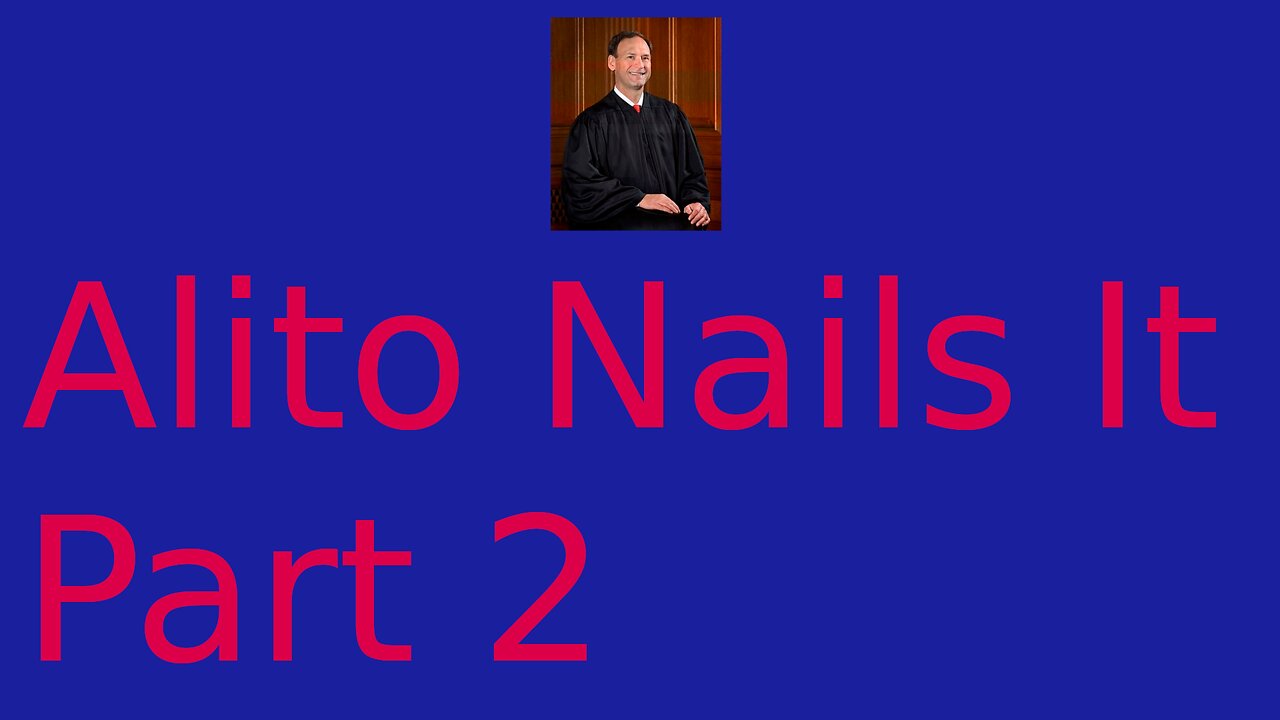Premium Only Content

Alito explained why Roe must go part 2
Alito explained why Roe must go
By Terry A. Hurlbut
On Monday, May 16, the Supreme Court will release “one or more decisions” from among its current cases. Does that include Dobbs v. Jackson Women’s Health Organization? The Court won’t say, and indeed never does. But with the illegal protests happening in front of five Justices’ houses, the Court might want to release their opinion in Dobbs just to get it over with. In anticipation of that, CNAV offers this analysis of the Alito Draft. It might show that apologists for abortion ruined their own case.
Will the Court release its opinion?
We know only, from SCOTUSblog, that May 16 will be an “opinion day.”
https://twitter.com/SCOTUSblog/status/1524787329579245568
As history shows, the Court never says in advance what opinions in what cases it will release.
https://twitter.com/AHoweBlogger/status/1524788784386215940
But we do know that demonstrations continue in front of the houses of five Justices, including Samuel A. Alito. He drew the assignment to write for the majority in Dobbs. And in his opinion, Roe v. Wade must go. Here again is the Alito Draft, so that readers may follow along.
https://cnavmedia.s3-accelerate.amazonaws.com/2022/05/scotus-initial-draft-opinion.pdf
Alito gives a timeline
Justice Alito begins with a simple timeline. Contrary to modern belief, individual States and territories wrote their own laws on abortion for 185 years. Alito includes, in two Appendices, thirty-seven citations of State laws forbidding abortions, thirteen citations of territorial laws, and one citation that made abortion unlawful in the District of Columbia.
Then came Roe v. Wade (410 U.S. 113, 1973), which upset thirty abortion prohibitions still on the books. Alito scolds the Roe court for:
• Bringing up the practice of abortion in ancient history (“constitutionally irrelevant”),
• Incorrectly asserting that abortion was never a crime in common law, and
• Handing down “a numbered set of rules” that read like an act by a legislature.
The Court actually weakened Roe in 1992 (Planned Parenthood of Southeastern Pennsylvania v. Casey, 505 U.S. 833). Alito tells us that the Casey court discarded the trimester system of Roe. Instead they said no State may impose an “undue burden” on a woman seeking an abortion. In the case at hand: wait twenty-four hours? Check. Minor girls getting parental or guardian consent? Check. But adult married woman getting the consent of the husband? No. And the Court gave no further guidance.
The ugliness of stare decisis
By far the ugliest part of the Casey opinion was the introduction of the phrase stare decisis into public discourse. Stare decisis is Latin for “to stand as decided.” As Alito scolded, it meant they had to leave the “central holding” of Roe intact, “even if that holding was wrong.” (Emphasis added.) To do less would be to undermine respect for the Court and for the rule of law.
And then the Court said one thing that, more than any other single thing the Court has ever said or done, provoked people to call it a group of “unelected bureaucrats in black robes.” They said:
We call the contending sides of a national controversy to end their national division
and treat their holding as final. That also is where the phrase “settled law” came from.
That case did like hell settle the controversy. Different States passed different laws. Advocates for abortion continued to sue away law after law – though occasionally the Court would chip away at Roe, bit by bit, though not as thoroughly as Casey did.
As CNAV covered, Texas passed its Heartbeat Act, that left enforcement to private citizens and granted them standing. So the angry abortion lobby sued immediately, asking in effect:
Are you going to let those Texas rubes do an end run around your law?
The Court effectively replied,
Call us when you have an actual controversy.
The Mississippi case – and Alito answers an ultimatum
And so we come to the case now at hand: Dobbs v. Jackson Women’s Health Organization. In 2018, Mississippi passed its Gestational Age Act, forbidding abortion after fifteen weeks. Immediately the managers, and one of the doctors, at the abortion mill sued. The U.S. District Court for the (presumably) Southern District of Mississippi enjoined the State through summary judgment. “Pre-viability” was their reason. The Court of Appeals for the Fifth Judicial Circuit affirmed.
Thomas Dobbs, as Chief Health Officer in Mississippi, petitioned for certiorari. Twenty-six States supported his petition. Furthermore, the petitioners directly attacked the Roe and Casey decisions, saying the Court made two bad decisions. The respondents said two things:
1. If the Court lets Mississippi ban “pre-viability” abortions, they might as well overrule Roe and Casey entirely.
2. “No half measures!” Either strike down this Mississippi law, or overrule Roe and Casey.
Well! If that sounds like an ultimatum, that’s because that’s exactly what it is. And from the preliminary vote, that seems to have been enough for Alito, Thomas, Barrett, Gorsuch, and Kavanaugh to say:
All right, you’re gonna get. Your. Wish.
If any one thing frosts a judge, it’s a party to a case daring to give that judge an ultimatum. So when Chief Justice Roberts assigned Samuel A. Alito to draft the majority opinion, anyone could predict the outcome.
Alito tears the Roe case apart
So Alito proceeded to tear the Roe case apart. As he notes, the Constitution and its Amendments never say a woman may have an abortion. The Roe court tried to find a right to abortion in the:
1. Ninth Amendment (abortion as a right the people retain),
2. First, Fourth and Fifth Amendments (security of the person, and so forth), or
3. Fourteenth Amendment (the Due Process Clause, that protects “life, liberty and property”).
An amicus brief tried to find that the Equal Protection Clause protects abortion as something only a woman would seek. But Alito points out that the Court has already ruled against that construction of that clause.
So – back to the arguments the Roe court made. The Fourteenth Amendment protects two kinds of rights, those being rights that:
1. One can find in the First Eight Amendments, and/or
2. Have deep roots in American history and tradition, and are necessary to the American system of ordered liberty.
The right to keep and bear arms satisfies both counts, and so does the prohibition of excessive fines. But abortion appears nowhere in those eight Amendments. And as for rooting in history and tradition, Alito cites traditions of common law, and American State statute, forbidding abortion. Lawyers will recognize the names of the great common-law scholars: Blackstone, Coke, Hale. All say that abortion, especially after the baby starts moving, is a crime.
Zero! None!
Most tellingly, he says this:
Until the latter part of the twentieth century, there was no support in American law for a constitutional right to obtain an abortion. Zero. None.
Furthermore the only reason to use “quickening” as a threshold was that doctors originally couldn’t even tell that a woman was pregnant. Now that we can easily tell, “quickening” must fall by the wayside. Which it did in the nineteenth century. By 1868 all States made abortion criminal. Alito scolds respondents and their friends of the court for:
1. Ignoring this history, and then
2. Saying the history doesn’t matter.
One friend of the court tries to say the legislatures, in criminalizing abortion, did not want Catholic immigrants to out-breed Protestant natives. Catholics wouldn’t get abortions, this theory ran, so the law mustn’t let Protestants do it either. To that, Alito effectively says:
If that’s the best you’ve got, that shows that the Roe and Casey courts had nothing to support their decisions.
Besides, that friend of the court has statements from supporters of those laws but not from actual lawmakers.
Central to the concept of ordered liberty? Not so much
But is abortion central to the very notion of liberty? The Casey court did hold:
At the heart of liberty is the right to define one’s own concept of existence, of meaning, of the universe, and of the mystery of human life.
Alito rightly points out that you can think and say what you wish about these things, but you may not always act on your thoughts or feelings. That’s why, incidentally, the law has treated harshly those who, from time to time, have bombed abortion mills, killed their doctors or other staff (in or out of the places of practice), or both. That is also why we do not (so far) recognize the radical Muslim concept jihad as justifying murder or treason.
Ordered liberty sets bounds between competing interests. In simpler terms, your right to swing your fist ends at the tip of my nose.
Finally, Alito addresses squarely those who tried to find support for Roe and Casey in other cases recognizing rights to personal decisions. The Solicitor General cited cases like Loving v. Virginia, Griswold v. Connecticut, and so on. (That officer also cited cases decided after the Casey decision. But we know that no case can rely on cases decided in its future. Justices of the Supreme Court are not time travelers.)
Alito points out this important difference. Abortion destroys life. “Miscegenation” does not destroy life. Contraception might stop life from starting, but does not destroy life. Abortion does.
Alito sets limits on stare decisis
At last Alito comes to the stare decisis doctrine. He doesn’t throw it out the window. But he does point out that the Court has already set limits on it.
Time does not sanction an error of the Court in interpreting the Constitution. The history of the Court is replete with such errors – which the Court has corrected. Sadly, the one exception to this was Scott v. Sandford, that took a War Between the States to correct. But as to the rest: the Court made a clear mistake in Plessy v. Ferguson (1896), and would not correct that until 1954 (Brown v. Topeka Board of Education)! In so correcting, the Court set a record for how long it let a bad precedent stand before overruling it. For fifty-eight years that precedent stood. Against that, the Court would act more timely by reversing a forty-nine-year-old error.
Again, that’s the record. Most reversals happen far more quickly, say in twelve or nine or even three years.
Five standards for overruling a precedent
Alito sets five grounds for overruling a bad precedent:
• Nature of the error,
• Quality (or lack of quality) of the reasoning behind it,
• Workability of the original rule,
• Effect on other areas of law, and
• Interests of various parties that rely on continuing the error.
By all such standards, Roe and Casey must fall. Alito’s quarrel with Roe and Casey was that it took a question no Court could settle, out of the hands of legislatures and the people. Alito doesn’t actually say that abortion kills a baby. Rather, he says the people cannot agree and the Court shouldn’t try to settle that one way or another. The Court tried in Roe and Casey, and shouldn’t have.
He also found the reasoning very weak, especially given the “viability” standard. Viability depends on best medical practice and research. It’s gotten better all the time—in the hands of doctors having patients who desperately want to save young lives.
Which leads to his next objection. “Viability” and “undue burden” don’t work. They don’t work because who’s to say whether an unborn child is viable or not, or whether a burden is due or undue?
He shows bad effects on other areas of law by citing case after case in which the Court has carved out exceptions to long-standing principles of jurisprudence.
About that reliance interest
A court creates a reliance interest when people must plan an act and know far in advance whether that act will still be legal. In nearly every single case involving abortion, people do not plan for it ahead of time. Furthermore, even the Casey opinion conceded that
Reproductive planning could take virtually immediate account of any sudden restoration of state authority to ban abortions.
When might the Court upend someone’s plans? Some women have said on social media that if Roe goes, “hookup culture” goes with it. Several have already said they will no longer have sex casually. When they express a fear of pregnancy, they concede that no contraceptive method is foolproof.
One woman said:
Since about 75% of men only care about sex and money I hope they know that this roe v wade decision could destroy hook-up culture and leave them paying 18 years of child support.
Lay aside whether that statistic is accurate or not. CNAV holds that forcing any man to accept responsibility for the children he sires, in or out of wedlock, can only do good for civilization.
Must our society permit abortion to let women take equal part in American economic and social life? Alito defies any Court to answer that. CNAV answers: no. The question assumes that motherhood gives no value to society – obviously false. It also denies that men have any similar obligation to balance work and family life. And that is also false, for reasons beyond scope here.
Alito addresses the shaking of the faith in the Court
The Casey court said one other thing directly relevant to current events. They said that overruling Roe entirely would shake the public’s faith in the Court. The Court, by this theory, must stick to what it has decided or leave people wondering whether it caved to public pressure.
Public pressure works both ways. CNAV will not deny the history of Marches for Life, because your editor took part in four of them. (See here, here, here, and here.) Never at any time did March organizers even think of demonstrating in front of the homes of Justices most likely to decide to uphold Roe and Casey. That’s probably because everyone knew that’s against federal law.
Justice Alito says the obvious: you do not let error stand permanently. The Court didn’t let Plessy v. Ferguson stand, and no more than one or two people would have wanted that. So if anything, overruling Roe and Casey, far from shaking public faith in the Court, would restore it.
Last, Alito applies rational-basis review to the matter at hand: the Gestational Age Act in Mississippi. He identifies several bases for upholding this law:
1. Respect for and preservation of prenatal life,
2. Protecting the health and safety of the mother,
3. Eliminating a gruesome medical procedure (and preserving the integrity of the medical profession),
4. Relieving pain and suffering of the unborn child, and
5. Preventing discrimination.
The first four, by themselves, justify stopping abortion after fifteen weeks.
Conclusion
The draft opinion orders remanding the case to the Fifth Circuit, telling them to decide the case knowing that Roe and Casey no longer apply. Even Chief Justice Roberts would agree with that, though for reasons he has not yet made clear.
Sadly, someone has already tried to influence the Court. This case has paralyzed the Court as no other case has before this. As Alito points out, the Court tried to protect, and stand, on its prestige, and lost. Events have also vindicated Thomas Jefferson, who decried the idea that
the Constitution is a mere thing of wax in the hands of the judiciary, which they may twist and shape in any form they please.
To which Alito now cries, “Enough!” Or in the language of his ancestors, “Basta!”
Then someone leaked his draft, after no other member of the Court wrote anything in reply for nearly three months. Now he and his family have had to leave their house and hide. Someone has poured contempt on the Court, and it’s not Justice Alito, and it’s not anyone on the pro-life side.
Again, the Supreme Court has an Opinion Day next Monday. We’ll see whether they release an opinion in Dobbs. If the Court wants to preserve its dignity and integrity, it will stand on Alito’s opinion. Furthermore, Alito will acknowledge and rebut Roberts’ concurrence and three likely dissents, and the Court can move on.
Link to:
The article
https://www.conservativenewsandviews.com/2022/05/14/accountability/judicial/alito-explain-roe-go/
The Alito Draft
https://cnavmedia.s3-accelerate.amazonaws.com/2022/05/scotus-initial-draft-opinion.pdf
Videos
https://youtu.be/L1xPlz2VI8c
https://youtu.be/p03350Mo2Io
https://youtu.be/9ohb9sMTDkE
https://youtu.be/KS3jpkOLe94
https://youtu.be/67rxruV5hUg
https://youtu.be/ftVwKga1Lfc
https://youtu.be/OaifM1tMkB0
https://youtu.be/lpXCtMqAB8o
https://youtu.be/SmJ0xQS15WQ
https://youtu.be/EoUVwbqJGGA
https://youtu.be/0q2WxNy6D6A
https://youtu.be/y77pnYF7bKc
Conservative News and Views:
https://www.conservativenewsandviews.com/
The CNAV Store:
https://cnav.store/
BitNext:
https://bitnext.app/landing/
-
 23:08
23:08
Declarations of Truth
4 months agoMeasurement and American patriotism
2391 -
 LIVE
LIVE
Donald Trump Jr.
2 hours agoCan California be Golden Again? Interview with Gubernatorial Candidate Steve Hilton | TRIGGERED Ep.293
6,475 watching -
 LIVE
LIVE
BonginoReport
1 hour agoTrump, Vance “SNUBBED” by Never-Trumper Cheneys - Nightly Scroll w/ Hayley Caronia (Ep.182)
3,729 watching -
 1:25:13
1:25:13
Kim Iversen
2 hours agoMKUltra Victims Are SUING — The CIA's Darkest Secret EXPOSED
20.8K26 -
 16:30
16:30
Stephen Gardner
2 hours ago🚨OVAL OFFICE EXPOSES TRUMP TAKEOVER – FILIBUSTER NUKED!
2.58K10 -
 1:34:03
1:34:03
Redacted News
2 hours agoBREAKING! CIA FURIOUS & EMERGENCY WHITE HOUSE MEETING - ISRAELI SPY CAUGHT MEETING WITH AMB HUCKABEE
98.1K95 -
 1:22:06
1:22:06
vivafrei
3 hours agoCFIA Goes After a REFUGE? Charlie Kirk Missing Evidence "Uncovered"? Democrats are Epostein Simps!
104K44 -
 1:44:33
1:44:33
The Quartering
4 hours agoTrump Calls For Hangings, McDonalds SNAP Controversy, The Demonic Relationship In Wicked & More
134K59 -
 21:40
21:40
Bitcoin Policy Institute
7 hours agoCongressman Warren Davidson Unveils the “Bitcoin for America Act” | Spotlight Series #1
13.4K -
 LIVE
LIVE
LFA TV
20 hours agoLIVE & BREAKING NEWS! | THURSDAY 11/20/25
1,067 watching